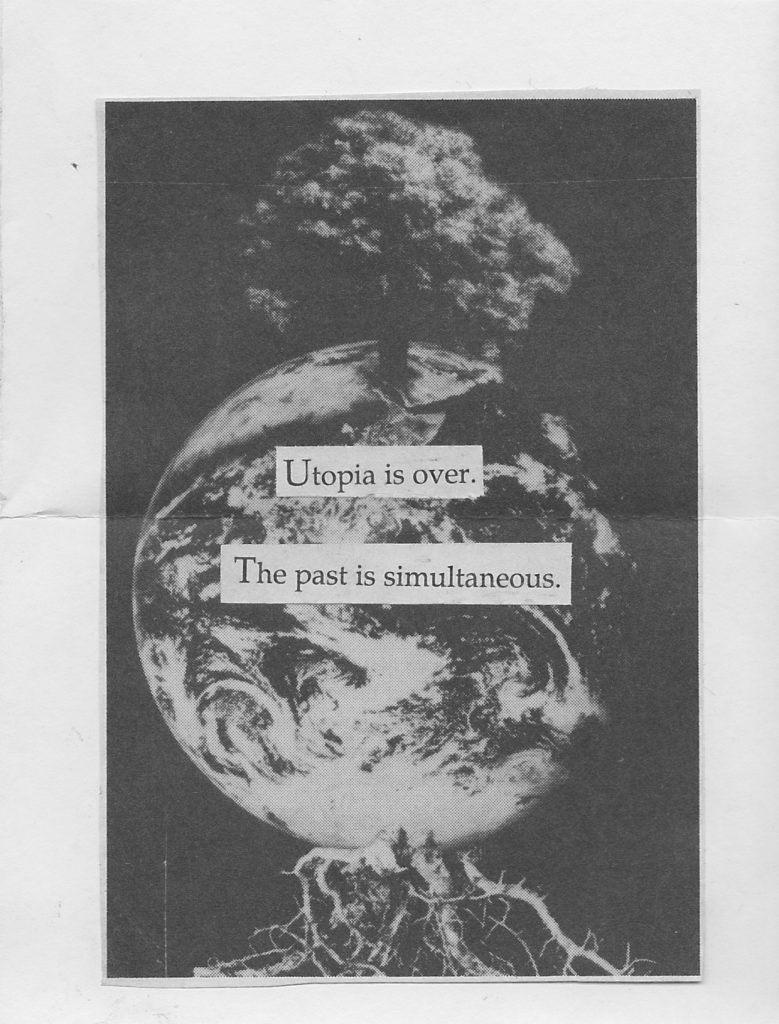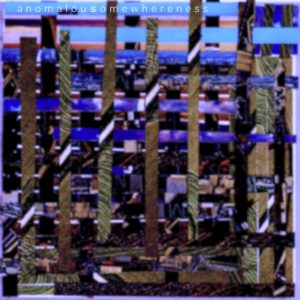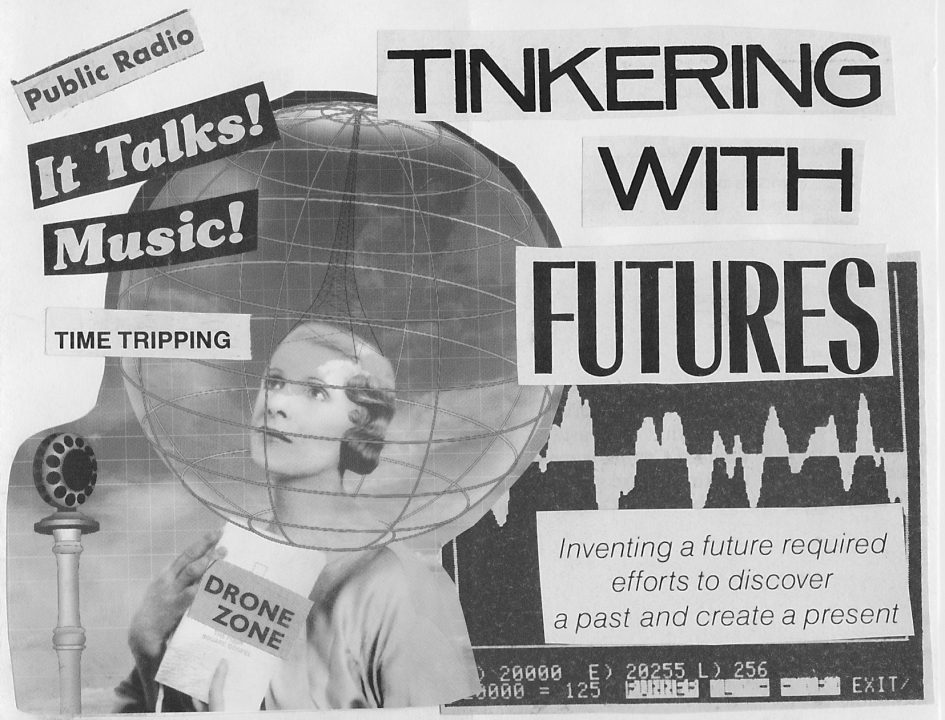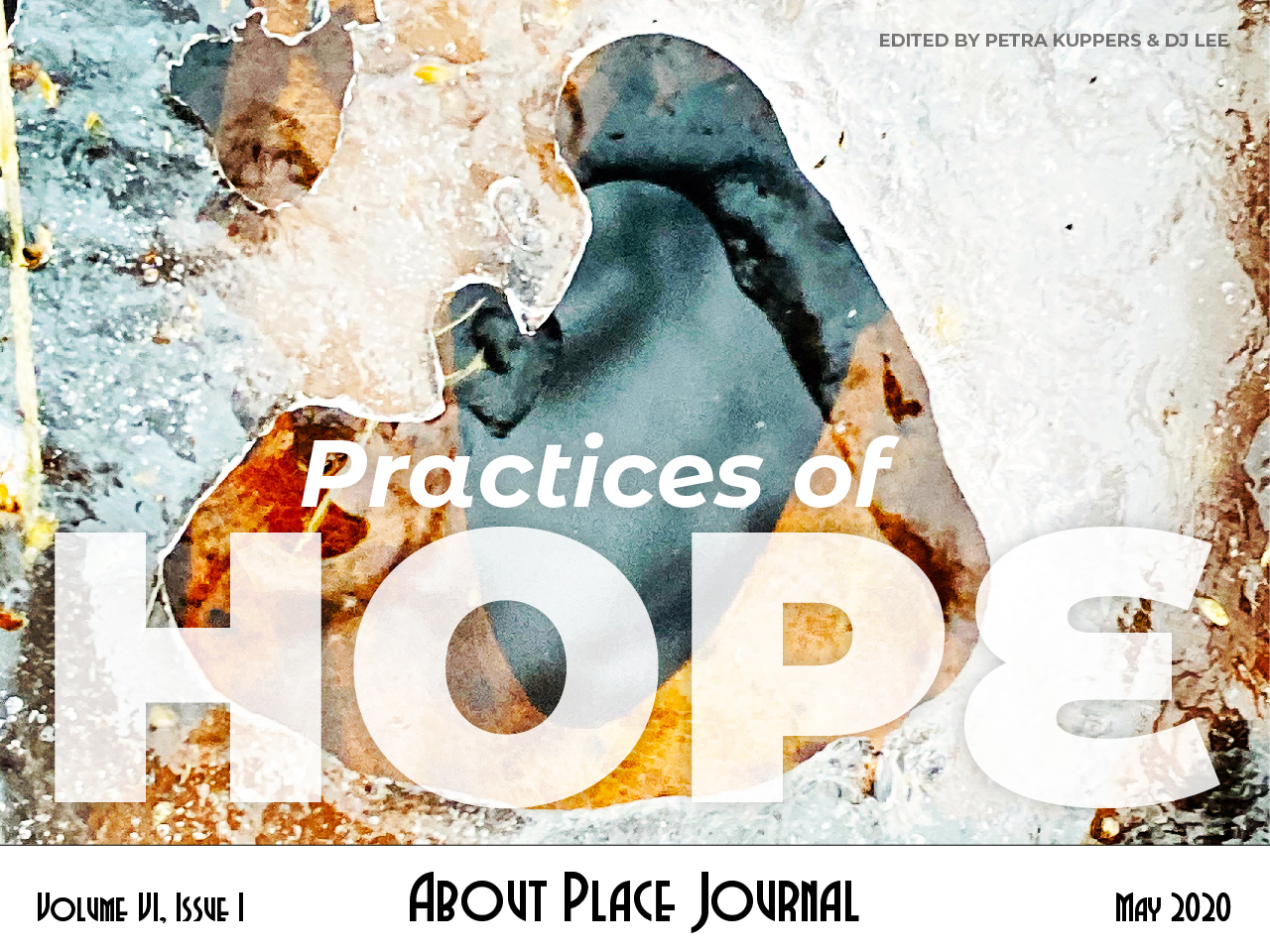Walking along the open and solitary Blackland Prairie, my black and brown speckled cattle dog trots ahead, pausing to look back and confirm I am safe and keeping pace. It is a place that feels utterly empty of humans, then the low hums from distant highways fill the background, and airplanes soaring miles above remind us of civilization. Our persistent anthrophony interrupts the quiet moments in our soundscapes when geophony and biophony align in silence. In these moments of silence, I consider the possibilities of desolation.
The incessant interruptions from civilization and the oblivious happiness of my companion inspire me to imagine new possibilities of co-habitation embracing sustainable creation and connection. Crisis fatigue, environmental grief, and generational guilt can lead to despair, but may also encourage collaboration, invoke our imaginations, and evoke activism through creative expression. One can still have a sense of hope while understanding the painful depths of our climate crisis. We learn to creatively reuse our surroundings, abilities, and environmental imaginations in order to recover materials and discover sustainable mediums.
At the intersection of the North Texas Blackland Prairies and Cross Timbers Forests, I contemplate my place and pace within past, present, and future environmental interactions. We live within persistent limitations and contradictions, yet creative communities can offer respite through connection and experimentation. I attempt to realize my collective subject position and understand that “situated knowledges are about communities, not about isolated individuals.” I aspire to share in ecological hope with community through transdisciplinary environmental philosophy that evokes our ecological imaginations and maieutic practice. Through environmentally themed zines, multimedia performance eco-art, soundscape ecology, and slow radio, I attempt to bring our latent ideas into clearer consciousness and offer possible guides for environmental perception where “the only way to find a larger vision is to be somewhere in particular” (Haraway (1), 590).

An accessible medium to imagine your particular understanding while simultaneously and immediately participating within an expansive community that interconnects histories and places are zines. Do-it-yourself, homemade and locally distributed publications – “[zine] concerns are common to all: how to count as an individual; how to build a supportive community; how to have a meaningful life; how to create something that is yours” (Duncombe, 18). Creative expressions, political rantings, identity reclamations, and freeform writings have a home in the world of zines.
Zine making reuses materials, repurposes understandings, and reacts against the biocultural loss and homogenization occurring at rates faster than we can resist. We collage our dreams, address our community problems, write new narratives, and tell forgotten stories. In the current system that isolates us and leaves us without choice, zines allow us to share our belongings and recover our sense of belonging. Zine sharing is a practice in an ethic of participation that combats consumer profiles and capitalist plans.
Community zine festivals and parties, artist collectives and micro-publishers, individual distributors and zine hobbyists perpetuate the practice to create our own media and offer avenues for transformation. The ethics of participation and reciprocity, social equity, and accessibility of zines reinforces the ability to realize and acknowledge alternative systems that can and do exist (Leonard). They offer authentic realizations and future scenarios that may cause discomfort. Zines have always challenged the status quo, and provide the historical understanding that self-publishing is a means to subvert and disrupt norms, while simultaneously building up radical community care and love.

Collaborating within creative and social collectives can seem utopian; there is focus on consensus, care, mutual aid, and respect. I have studied abroad with academic conservation programs in collaboration with indigenous communities, grown organic food on small sustainable farms with femme and queer farmers, co-maintained a pay-what-you-want volunteer run restaurant with Catholic Workers and activists, joined mixed media art collectives, hosted community gatherings and shows, and developed local nonprofit organizations. I have also been a part of the demise, dismantling, and stumbling of these programs and organizations.
Realizing the death of a utopia necessitates the imagination to seek and create new connections. We continue to pursue the trapdoor utopia – the secret pathways toward restoration and reverence that may only lead to unknowns and uncertainties. We embrace these mysteries with collectives of poets, writers, musicians, artists, gardeners, technicians, and creatives that use any skills they can offer to perpetuate a utopian dream, acknowledge our dystopian reality, and perform these countless possibilities in public and for ourselves. We will build our home with the remnants of lost utopias.

We creatively reuse the remains and debris of lost utopias and dystopias, in order to blend our realities and imaginations. We situate ourselves in what we individually comprehend, and search for creative practices to welcome others into those ephemeral futures. An art collective can provide spaces for performance, growth, healthcare, self-care, and community-care. We play with the boundaries between individual and community, permanence and transience, fiction and nonfiction.
I incorporate queer ecology that is interdisciplinary and “uses biology and evolution to contextualize non-normative sexualities, adaptations and presentations” (queerecology.org). Queer ecology is reminiscent of cyborg genders, in that it “is a local possibility taking a global vengeance,” where “there is intimate experience in boundaries, their construction and deconstruction” (Haraway (2), 316). Visceral multimedia performance eco-art nurtures new depths to our perceptions while challenging boundaries. Ambient soundscapes comprised of melodious synthesizer sounds, discordant sound effects, vocal manipulations, and field recordings of natural and found sounds from various environments “indicate[s] that a certain level of privacy, self-possession, and means for material possession prefigure and sustain [our] artistic output. Yet individual efforts are balanced with various types of collaboration… both are necessary” (Rodgers, 243).
The boundaries between hard and soft, natural and technological, artists and environments are disrupted. In a costume designed with fabrics, fibers, and accessories sustainably sourced from creative reuse centers, the garment wraps around me and encompasses my body: distorting my identity, disrupting my vision, and increasing the mass of my physical self. I feel the weight of our overconsumption as materials that were destined for the waste stream smother me. Handmade pom-poms with repurposed fibers, splashed with essential oils that help with memory, relaxation, and energy, are tossed at the audience during performances (and some tossed back at me), in order to play with the boundaries between art and audience, and what we give to each other. Through this mixed media collage of sound, zines, fibers, and performance, I hope to foster multisensory ecological reveries and perceptions.
Transdisciplinary environmental imagination and ecological aesthetics in maieutic practice may prevent the destructive consumption of the environment in recreational, educational, and industrial uses. We bring latent ideas into clear consciousness evoking “the outstanding characteristic of perception…that [it] entails no consumption and no dilution of any resource… To promote perception is the only truly creative part of recreational engineering” (Leopold, 290). We can perceive a multitude of means for ongoing finite embodiment with limited resources. We find unexpected openings and connections to our collective subject position through “translations and solidarities linking the cacophonous visions and visionary voices that characterize the knowledges of the subjugated” (Haraway (1), 590). We find this anomalous somewhereness weaving through our landscapes and communities.

Inspired by the cacophonous and visionary spontaneity of creative communities, soundscape ecology is incorporated into my artistic practices. Soundscape ecology is made up of geophony (non-biological audio sources), biophony (the collective sound that vocalizing animals create), and anthrophony (human made/created sounds and noises). “Every soundscape that springs from a wild habitat generates its own unique signature, one that contains incredible amounts of information” (Krause). In soundscape ecology, aural perceptions and deep listening spark our environmental imaginations.
The influence soundscape ecology can have on an audience is encompassing and palpable, and goes beyond solely aural understandings. Sounds can be tangible, they can reverberate through our bodies, they can pull us in, or push us away. Spectrograms reveal images that display the sounds according to brightness and color, frequency, and time of occurrence. We become more aware of our perceptions, connections, and expressions. Soundscapes influence the imagination to be both a framing device and a presence mediating human and natural histories. The ability to organize and conceptualize environmental interactions requires an ecological imagination to guide our ways of perception (Buell). Soundscape ecology helps preserve and share the signatures of habitats, and provides a medium for archiving a necessary aspect of our conservation hopes.
We learn to reuse transformative domains, embrace the uncertainties that nature presents us with, and learn from generations of those that have cared for the earth in previous centuries. Environmental restoration may be the art form of the 21st century, and requires we find just and sustainable practices with intermingling mediums. Created in the late 19th century and developed during the 20th century, radio is a medium of our past providing new creative means for future transmissions. Community-powered stations are cropping up again and providing new domains for creatives, audiophiles, volunteers, and enthusiasts to become “the blood of the station, and if [we] care for them, they will care for the air. And it is a garden that needs tending, constantly, and well” (Milam, 46).
In North Texas, a small Low-Power FM station and nonprofit radio organization aspires to cultivate hope and love through shared music, sounds, stories, and productions that remind us of the powerful unity that people can create when we care for shared commons. Real Waves Radio Network manages KUZU 92.9 FM in Denton, TX – a nonstop, community supported, LPFM radio station with a drive to combat the homogenization of media. We transmit forgotten songs and stories of generations past, we provide spaces for subjugated and disenfranchised groups to be heard, we seek new and undiscovered talents, and we offer genuine expression of our community pulse and heartbeat.

IN FORMED Radio, a program on KUZU, incorporates slow radio, soundscape ecology, and public domain works. Using radio as a means to transmit transdisciplinary environmental philosophy is an attempt to make philosophy uncivilized, accessible, and freeform. “It is time to look for new paths and new stories, ones that can lead us through the end of the world as we know it and out the other side” (Hine). Public domain works are copyright free and available for the public to creatively reuse. The various episodes featuring fiction, nonfiction, poetry, and literary works present information that may inspire the audience to consider the topics of the past and gain new perspectives. Environmental and ecological themes are a persistent motif, and soundscape ecology from personal archives or public domain sources is integrated to provide listeners with biophonic and meditative moments.
In addition to presenting public domain works, we air interviews and recordings with artists and performers during their various practices, in order to enhance radio as a medium to showcase and express artforms not typically featured in a primarily aural domain. IN FORMED Radio is slow radio that is “an antidote to today’s frenzied world… [and] a lo-fi celebration of pure sound… to help you stay grounded in the present” (BBC). Through these transmitted expressions of text, performance, and soundscapes, we challenge contemporary conceptions of radio with glimpses from history, creative communities, and environments.
Projects like KUZU help us restore and transform broadcasting domains with repercussions we may never fully fathom. “You and I, caught in the transmission of generations of words – cascading them to the edges of our visible horizon: and perhaps even sending them to the outer edges of the universe to puzzle strange minds behind strange brows” (Milam, 20). Radio can be the cross-generational medium that persists into unknown potentialities. With radio, we have the means to transmit perceptions and expressions of past, present, and futures, while seeking and establishing just and sustainable transitions.
Situated knowledges help us comprehend the multiple generations, communities, ecosystems, and perceptions necessary for the hopeful transition to an ecologically and socially just future. We must listen to the knowledge-bearers and earth-caretakers of indigenous peoples, animals, and plants that have co-inhabited these areas for generations. At the intersection of North Texas Cross Timbers Forest and Blackland Prairie, we can study the ecotones with variable perspectives. The lichens, mosses, and microflora create miniature forests with high concentrations of biodiversity in tiny spaces. The larger habitats show evidence of scat, animal prints, native perennials and the daily happenings for the full-time residents of these spaces. At the macro level, we experience the intermingling of wetlands and flood plains, our Trinity River watershed, and the waterways all life relies on.
Transdisciplinary environmental philosophy shapes our imagination and consciousness. Maieutic practice helps comprehend the multitude of limits and contradictions bombarding our subject position. Creative expressions can cultivate recreational perceptions to inspire interest and promote knowledge about the natural world. Through accessible and participatory zine culture, multimedia performance eco-art, and freeform community radio, we attempt to expand and blend our boundaries. We seek and open trapdoors to find uncertain and exciting creative projects. We can dwell in unknown somewhereness, while building communities that tinker with potentialities and offer glimpses of new futures. Localized possibilities can amass to cultivate global retribution and disrupt false utopias.
References:
“BBC Radio 3 – Slow Radio,” BBC, accessed February 2020, https://www.bbc.co.uk/programmes/p05k5bq0
Buell, Lawrence. The Environmental Imagination: Thoreau, Nature Writing, and the Formation of American Culture. Cambridge: Belknap Press. 1995.
Duncombe, Stephen. Notes from Underground: Zines & the Politics of Alternative Culture. Portland, Oregon: Microcosm Publishing. 2017.
Haraway (1), Donna. “Situated Knowledges: The Science Question in Feminism and the Privilege of Partial Perspective.” In Feminist Studies, Vol. 14, No. 3, 575 – 599. 1988.
Haraway (2), Donna. “A Cyborg Manifesto: Science, Technology, and socialist-feminism in the late twentieth century.” In The Cybercultures Reader, edited by David Bell and Barbara M. Kennedy, 291 – 324. London: Routledge, 2000.
Hine, Dougald & Paul Kingsnorth. “From Uncivilization: The Dark Mountain Manifesto.” In The New Farmer’s Almanac 2015, edited by the Greenhorns, 299–302. New York: New York Press, 2015.
Krause, Bernie. “The voice of the natural world.” Filmed June 2013. TED video, 14:48. https://www.ted.com/talks/bernie_krause_the_voice_of_the_natural_world.
Leonard, Annie. The Story of Stuff: The Impact of Overconsumptions on the Planet, Our Communities, and Our Health – And How We Can Make It Better. New York: Free Press, 2010.
Leopold, Aldo. “Conservation Esthetic.” In A Sand County Almanac: with Essays on Conservation from Round River, 280–295. U.S.A: The Oxford University Press, 1966.
Milam, Lorenzo W. Sex & Broadcasting: A Handbook on Starting a Radio Station for the Community. Mineola, New York: Dover Publications, Inc. 2017.
queerecology.org. “About.” Accessed February 2020. http://queerecology.org/
Rodgers, Tara. Pink Noises: Women on Electronic Music and Sound. Durham: Duke University Press. 2010.


